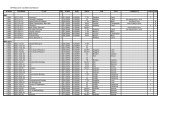Facility Rules and Regulations - West Virginia Wesleyan College
Facility Rules and Regulations - West Virginia Wesleyan College
Facility Rules and Regulations - West Virginia Wesleyan College
Create successful ePaper yourself
Turn your PDF publications into a flip-book with our unique Google optimized e-Paper software.
7. All participants are encouraged to bring a towel <strong>and</strong> water bottle.8. No food or drink, other than water, is permitted in the group exercise rooms.Safety Precautions <strong>and</strong> Basic Gym SafetyThis article's main purpose is to assure your safety, so that you get the most out of your workouts while avoiding injuries <strong>and</strong>/orother complications. It is imperative that you underst<strong>and</strong> <strong>and</strong> adhere to each of the following safety precautions.1.) Get a complete physical checkup before you start a strength-training program. You might have to modify or avoid weightlifting if youhave muscle or joint problems, seizure disorders, heart disease, high blood pressure, previous injuries or any other physical condition withpotential for danger.2.) Be sure to always integrate warm-ups, stretching, <strong>and</strong> cooling- down into your program. This will reduce your risk of injury by increasingyour blood flow <strong>and</strong> prepping your muscles for the work they are about to do. Using the proper lifting form is important not only to work yourmuscles correctly, but also to prevent injury. Always do your exercises through a full range of motion in a slow, controlled manner.3.) When beginning a new weightlifting program--or any time you try a new exercise--always start out using light weights. It is far better tostart out too light than too heavy. Choose a weight that you are sure is light <strong>and</strong> do a warm-up set of 15 repetitions, while perfecting thecorrect lifting technique. If the weight is too easy for 10 to 12 reps--in keeping with your goals--add a little more weight <strong>and</strong> gradually increasethat weight within the next few weeks.4.) Going to total muscle fatigue with a challenging weight is not useful objective in your first few weeks. When trying a new lift or starting anew routine, the objective is to practice <strong>and</strong> perfect your technique, <strong>and</strong> to learn how to concentrate on the muscle you are exercising.5.) Proper breathing is essential in weightlifting. If you hold your breath while lifting a weight, you run the risk of raising your blood pressure<strong>and</strong> starving your brain of oxygen. You should try to exhale during the "positive," or main exertion phase, <strong>and</strong> inhale during the "negative,"the phase in which you resist <strong>and</strong> come back slowly. If this becomes too confusing or takes away from your concentration on the lift, don'tworry about it--just remember to breathe.6.) Do not leave equipment lying around the weight room where someone could trip over it. Always use the collars that prevent weights fromfalling off the barbells. Be sure to keep your h<strong>and</strong>s away from the chains, cams, pulleys, <strong>and</strong> weight plates of exercise machines when theyare in use. Also, when selecting the weight for a machine exercise, be sure to push the pin in all the way. Be sure to wear a weightlifting belton exercises that place stress on your lower back, such as bent-over lifts like squats, or barbell rows.7.) Consider having a spotter. Having a spotter is important not only for safety reasons but also for performance enhancement. Few thingswork as well as a conscientious, knowledgeable spotter or workout partner who dem<strong>and</strong>s proper technique <strong>and</strong> full effort on every exerciseset <strong>and</strong> repetition. An effective spotter gives encouragement, technique, feedback, <strong>and</strong> just enough assistance to permit completion of thatfinal, difficult, repetition. No matter what your goal reps are, each set should end with the last repetition being challenging; you should try togo to muscle fatigue. Given this goal, there is always the chance that when trying for a final repetition, you just can't do it all on your own.This is where your spotter comes in--helping you just barely finish that last rep, <strong>and</strong> assuring you of your safety.8.) If you do not have a workout partner at first, we strongly recommend trying to find someone with similar goals <strong>and</strong> interests to work outwith you. This will not only help assure safety <strong>and</strong> motivation, it will also help you make it to the gym more often. If you aren't working with apartner at a gym, either ask a staff member or someone who looks experienced for a quick "spot". Most people will be happy to help you. Besure you <strong>and</strong> your spotter have a plan so that each of you knows exactly what the other will do in case you need assistance.9.) It is also important that you know how to correctly spot someone to assure his or her safety. When spotting someone, always beprepared to give a little assistance when they reach muscle fatigue (cannot complete the rep on their own). You don't want to help so muchthat the rep becomes easy for them to complete--give just enough assistance so that they can complete the set, but it is still challenging forthem. Also, only provide assistance on the positive phase (the part that requires the pushing or pulling motion). Still have your h<strong>and</strong>s readyto help, but don't help with the negative phase (the part where you resist the weights force)--the lifter should try to slowly resist the force ofthe weight all on his/her own.
















